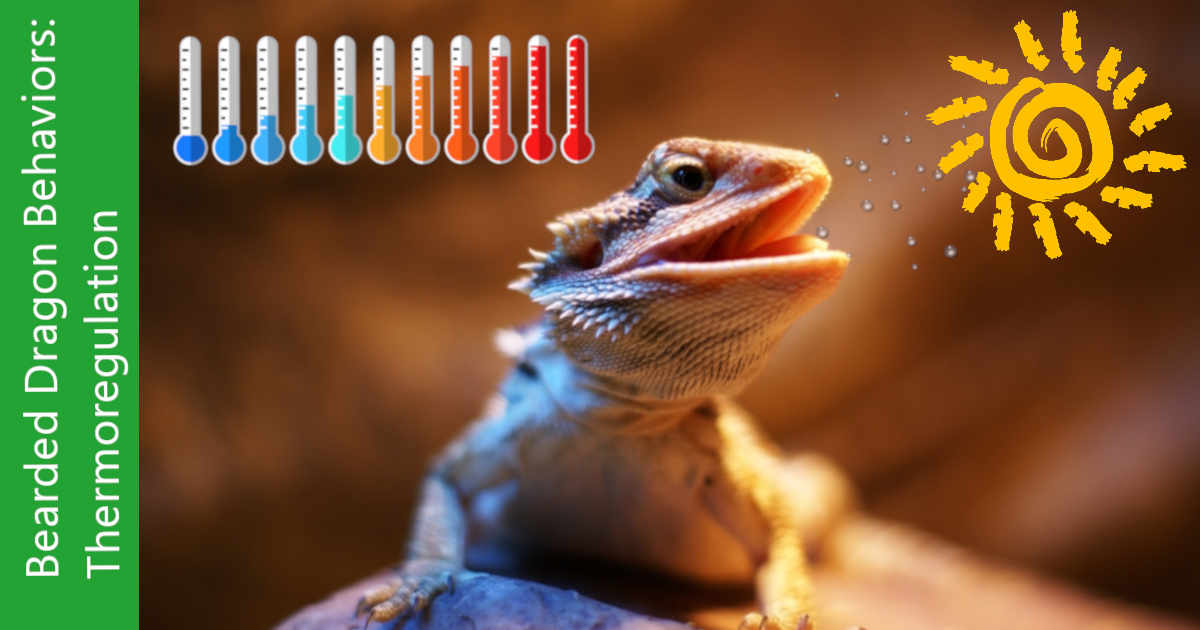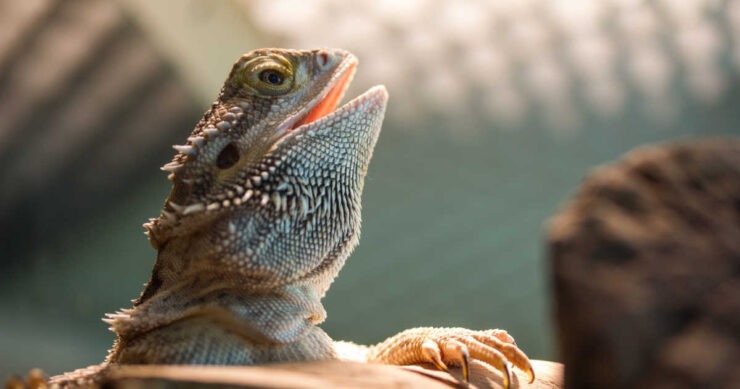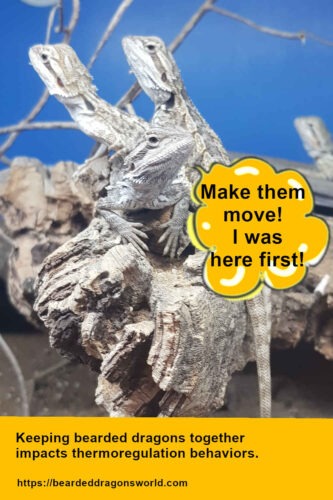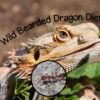Bearded dragon thermoregulation is a key aspect of their biology, integral to their survival and well-being. These reptiles are equipped with unique adaptations that enable precise control over their body temperature. This capability, vital for their overall health, impacts their metabolism, digestion, and activity levels. As ectotherms, bearded dragons depend on the external environment to regulate their body heat, placing significant emphasis on the quality and temperature of their habitat for optimal care.
The response of bearded dragons to temperature variations is multifaceted, influenced by the quality of their environment. Therefore, their habitat requires meticulous management and monitoring to satisfy their specific thermoregulatory needs. In their natural settings, bearded dragons demonstrate various behaviors to maintain an ideal body temperature, such as basking, seeking shade, and adjusting their orientation towards or away from heat sources.
Bearded dragon thermoregulation involves both voluntary and involuntary behaviors for temperature regulation. These include changing their skin color to influence heat absorption, gaping to expel excess heat, and moving between areas of different temperatures. They also strategically modify their body orientation and posture to either increase or decrease heat absorption, tailoring their response to their immediate thermal requirements. Collectively, these adaptive behaviors are critical for bearded dragons to keep their body temperature consistent within a narrow body temperature range, even when external temperature varies significantly.
This blog post explores scientific research examining how bearded dragons adapt their thermoregulatory behavior in diverse temperature environments. These studies provide critical insights into the necessity of appropriate environmental conditions for bearded dragons, highlighting the impact of temperature on their well-being and care. For pet owners, understanding these behaviors is crucial to ensuring a healthy and comfortable life for bearded dragons in captivity.

Jump To…
Bearded Dragon Thermoregulation: Key Behaviors
Thermoregulation is an essential aspect of bearded dragon care. These unique reptiles have several behaviors that help them regulate their body temperature due to their ectothermic nature.
Bearded Dragon Gaping
Bearded dragon gaping is a primary method of thermoregulation usually in response to high temperatures. Bearded dragon gaping involves opening their mouths wide and is a passive method aiding in evaporative cooling. This behavior is particularly noticeable when they bask in sunlight, allowing heat exchange through their open mouths.
In their natural habitat, bearded dragons exhibit gaping behavior at specific threshold temperatures. Studies have shown that these reptiles typically start gaping around 36.9°C, a temperature that triggers their thermoregulatory response. This gaping behavior is not only a physical response but also involves physiological adjustments such as heart rate changes and blood flow alterations.

Gaping Mechanisms and Their Impact
There are different levels of bearded dragon gaping based on the degree their mouth is open and dependent on how fast they intend to change their body temperature:
- Minimal opening, barely distinguishable from a closed mouth.
- Moderate opening, more than a few millimeters.
- Wide open mouth with visible tongue and expanded throat.
When gaping is not possible, bearded dragons may adjust their orientation or position to manage their heat exposure.
The level of gaping reflects the lizard’s control over its thermoregulatory response, adjusting the gaping degree according to the temperature
Gender Differences in Gaping
Research indicates that gender may play a role in the thermoregulatory behavior of bearded dragons. Females tend to initiate gaping at slightly lower temperatures compared to males. This difference could be attributed to variations in metabolic rates or hormonal influences between the sexes.
Environmental Influences on Gaping
External temperature and humidity levels significantly influence gaping frequency.
Ambient Temperature: The primary trigger for gaping is the external temperature. Bearded dragons use gaping more frequently as the ambient temperature rises, helping them to dissipate heat effectively.
Humidity: High humidity levels can affect the efficiency of evaporative cooling through gaping, thereby influencing the frequency and duration of this behavior.
Harsh Environments: In harsh environments, bearded dragons may limit or cease thermoregulatory behaviors to conserve resources.
Moving Position in Preference to Gaping
A recent study by Black, Aedy, and Tattersall (2021) showed that when gaping was prevented, the lizards compensated by orienting their heads toward the heat source, presumably to increase the heat transfer from their head to the environment. They also moved to a position in their cage to temperature that was lower than what they preferred, This suggests that bearded dragon gaping is a costly behavior for them and they would prefer a lower temperature than to gape.
Bearded Dragon Panting
Bearded dragon panting is different to gaping. When a bearded dragon pants, it changes the way it breathes. Panting means breathing faster but each breath isn’t as deep as normal. It’s like taking quick, shallow breaths instead of slow, deep ones.
When a bearded dragon is panting it helps it to cool down, especially when it gets really hot. This method is more commonly seen in mammals like dogs as a response to intense heat stress when they are trying to cool off.
Shuttling
Shuttling is when a bearded dragon transition between zones of warmth and coolness. This action is a thermoregulatory tactic to achieve and sustain an ideal internal temperature.
Changing Color
A bearded dragon can change the color of its skin to reflect or absorb sunlight, which can help them regulate their body temperature by adjusting their heat absorption or reflection.
Orientation and Posture
Beraded dragons may adjust their oreintation and posture relative to the heat source, so that they can control the amount of heat they absorb or lose from their environment.
In the wild, if a bearded dragon wants to warm up, it will orient its body perpendicular to the sun’s rays to maximize the surface area exposed to the sun. This increases the amount of heat absorbed by the skin and raises the body temperature. Conversely, if the dragon wants to cool down, it will orient its body parallel to the sun’s rays to minimize the surface area exposed to the sun. This reduces the amount of heat absorbed by the skin and lowers the body temperature.
The orientation of the head is also important for thermoregulation. Bearded dragons use their head as a primary heat sensor, and they can adjust their head orientation to detect and locate heat sources. For example, if they sense a hot rock nearby, they will orient their head toward the rock to increase the heat transfer from the rock to their body. They can also use their head orientation to avoid overheating or burning themselves by moving away from the heat source.
Research conducted by Black and Tattersall has shown that bearded dragons, both young and mature, exhibit a strategic positioning relative to their heat source. These reptiles show a preference for orienting themselves towards a heat source to maintain their preferred body temperatures, which average around 33 to 34 degrees Celsius. In situations where the ambient temperature is on the lower side, adult bearded dragons tend to orient themselves more directly towards the heat, a behavior that decreases as ambient temperatures rise. This adaptive positioning is indicative of a thermoregulatory mechanism to achieve a balance in body temperature. On the other hand, younger bearded dragons displayed a tendency to opt for cooler temperatures even when positioned towards a heat source. This inclination appears to diminish as the dragons age, suggesting a learning curve in their thermoregulatory behavior that enhances with experience.
The role of orientation in thermoregulation is not limited to bearded dragons. Many other animals, including insects, reptiles, and mammals, use orientation to adjust their body temperature. For example, some insects orient their wings to reflect or absorb sunlight, while some reptiles orient their bodies to maximize or minimize the exposure to the sun.
Bearded Dragon Thermoregulation when Housed Together
Keeping bearded dragons together also impacts thermoregulation behaviors.
A scientific study by Khan, Richardson, and Tattersall investigated the thermoregulation and aggregation behavior of neonatal bearded dragons (Pogona vitticeps). The researchers used 79 baby dragons that were about 3 grams in weight and 10 cm in length, which is roughly the size of a human finger.
The researchers showed that both those kept on their own and baby beared dragons that were grouped together achieved a similar level of thermoregulation. This means they were able to reach their preferred body temperature of around 35 degrees Celsius. However, the bearded dragons being kept together had more variation in their skin temperature, their thermoregulatory precision was lower than those kept on their own. This could be because they had to move more often to avoid or compete with their group mates.

The researchers were also able to show that both baby bearded dragons kept on their own and those in kept together were attracted to a light bulb when it was on, regardless of the ambient temperature. This suggests that the light bulb was a valuable resource for the bearded dragons, as it provided both heat and UV light. They also tended to orient their heads toward the light bulb, which could help them absorb more heat and UV light. However, when the light bulb was off, the dragons moved away from it and oriented their heads randomly.
The researchers concluded that baby bearded dragons will group together through mutual attraction to a common resource, such as a heat source. They also suggested that increased variability in thermal preference (the temperature that they like) occurs in groups, which could lead to conflicts or segregation among the bearded dragons.
The Effects of Extreme Conditions on Bearded Dragon Thermoregulation
Thermal Quality
Thermal quality is how easy or hard it is for an animal to find and keep its preferred body temperature in a given environment. A high-thermal-quality environment has a wide range of suitable temperatures that are close to each other, while a low-thermal-quality environment has a narrow range of suitable temperatures that are far apart. For example, a thermal gradient that goes from 15°C to 50°C is a high-thermal-quality environment, while an environment that alternates between these temperatures is a low-thermal-quality environment.
A study by Cadena and Tattersall1 looked at how bearded dragons behaved in different thermal quality environments. They found that bearded dragons were able to regulate their body temperature within a narrow range by moving between the hot and cold parts of the environment, or by choosing where to be along the thermal gradient. However, they also found that the thermal quality of the environment affected how well bearded dragons could control their body temperature.
The precision of thermoregulation refers to how well an animal can keep its body temperature around a certain value, while the level of thermoregulation refers to the average body temperature that an animal chooses. The study found that bearded dragons were less precise and had a higher level of thermoregulation in low-thermal-quality environments than in high-thermal-quality environments. This means that they tolerated a wider range of body temperature and chose higher body temperature in environments where it was harder to keep their body temperature stable. This strategy may help them save energy in challenging thermal conditions.
The Impact of Starvation and Dehydration on Thermoregulation
Bearded dragon thermoregulation may cease In extreme scenarios like starvation or significant water reduction. In extreme conditions they may cease all activity, not just thermoregulatory behaviors, to conserve energy and resources. This survival strategy, however, means they stop regulating their body temperature, which can be risky in extreme climates.
The study that was published in 2015 in the Journal of Experimental Biology experimented with salt loading bearded dragons to mimic the effects of dehydration.
The study suggests that bearded dragons conserve water by reducing their evaporative cooling mechanisms when they face water stress, but still maintain their thermoregulatory behaviors when water is available. In other words, when a bearded dragon is dehydrated it cannot afford to gape which will loose further fluids. Instead it will turn to other forms of thermoregulation such as shuttling.
The study also reveals that gaping may have multiple functions for bearded dragons, such as fine-tuning their body temperature, dissipating excess heat, and cooling their brain. These functions may be important for their survival and performance in hot and variable climates, where they need to balance their energy and water budgets. The study also demonstrates that salt loading can impair these functions by inhibiting gaping and increasing the head and body temperatures, which may have negative consequences for the health of bearded dragons.
This study has implications for the pet care of bearded dragons, as it highlights the importance of providing them with adequate hydration, temperature, and light conditions. Bearded dragons should be provided fresh water and a varied diet that includes insects and leafy vegetables. They should also monitor the temperature and humidity of their enclosure, and provide them with a heat and UV light source that mimics the natural sunlight. They should also observe their bearded dragons’ behaviors, such as shuttling and gaping, and adjust the environmental parameters accordingly.
Optimal Environments for Bearded Dragon Thermoregulation
Creating the right environment for your bearded dragon is crucial for their health and well-being. Recent studies, including those by Cadena and Tattersall, offer valuable insights into their thermoregulatory behavior and preferences.
Understanding Thermal Quality
The thermal quality of an environment significantly affects a bearded dragon’s ability to maintain its preferred body temperature. Environments with a wide range of closely situated suitable temperatures are considered high-thermal-quality, while those with limited and scattered temperature ranges are low-thermal-quality.
For example, a thermal gradient that goes from 15°C to 50°C is a high-thermal-quality environment, while an environment that alternates between these temperatures is a low-thermal-quality environment.
Bearded Dragon Behavior in Thermal Environments
A study by Cadena and Tattersall1 looked at how bearded dragons behaved in different thermal quality environments. They found that bearded dragons were able to regulate their body temperature within a narrow range by moving between the hot and cold parts of the environment, or by choosing where to be along the thermal gradient. However, they also found that the thermal quality of the environment affected how well bearded dragons could control their body temperature.
Recommendations for Creating Suitable Environments
- Temperature Gradient: Instead of a uniform temperature, provide a thermal gradient in the enclosure. This allows your bearded dragon to select a comfortable temperature based on their current needs.
- Avoid Extreme Temperatures: Protect your pet from extreme or rapidly changing temperatures to prevent stress and physiological dysfunction.
- Regular Monitoring: Use thermometers to regularly monitor their body temperature, ensuring they remain within a safe and comfortable range.
- Controlled Lighting, Humidity, and Ventilation: These factors are crucial for effective thermoregulation and overall health, so maintain them at appropriate levels in the enclosure.
Special Considerations for Baby Bearded Dragons
Need for Temperature Control: Young bearded dragons require a well-regulated thermal environment, complete with a gradient and heat source. Monitoring tools like thermometers and hygrometers are essential.
Housing Bearded Dragons Together: While housing bearded dragons together may offer benefits like shared heat and UV light, it can also lead to competition and stress. Provide ample space and hiding spots to mitigate potential conflicts.
Observing Thermal Preferences: Baby bearded dragons may have varying thermal preferences, which can evolve over time or due to environmental changes. Keep a close eye on their behavior and adjust their environment accordingly, or consider separation if necessary.
Conclusion: Mastering Bearded Dragon Thermoregulation for Optimal Care
In the world of bearded dragons, understanding and supporting their thermoregulatory behaviors is key to their health and happiness. These fascinating reptiles, adapted to diverse thermal environments, require careful attention to their thermal needs for optimal well-being.
Essential Thermoregulatory Behaviors
Adaptation to Thermal Quality: Bearded dragons demonstrate remarkable adaptability to varying thermal conditions. They have distinct preferences and limits, and providing a suitable thermal gradient in their habitat is vital.
Gaping and Panting: Two key behaviors, gaping and panting, highlight their sophisticated thermoregulatory system. Gaping, primarily a passive form of evaporative cooling, is effective in hot, dry conditions, while panting involves more active, energy-intensive shallow breathing for rapid heat dissipation.
The Need for Proper Habitat Setup: Creating a habitat with a heat lamp, UV light, and temperature gradient is crucial. This environment allows bearded dragons to select their preferred conditions, promoting comfort and health.
Importance of Environmental Control and Hydration
Orientation and Positioning: Bearded dragons showcase an ability to adjust their body orientation and posture relative to heat sources. This critical behavior is part of their complex thermoregulation strategy.
Dehydration Risks: In arid or water-scarce environments, dehydration is a significant risk. It can severely impact their physiological functions, including thermoregulation, highlighting the importance of providing constant access to water.
Creating an Optimal Environment
Temperature Gradient: A carefully designed temperature gradient within the enclosure allows these reptiles to regulate their body temperature effectively.
Basking Spot and Hiding Places: Including a basking spot for warmth and hiding places for cooler retreats ensures a well-rounded habitat.
Ventilation and Humidity: Proper ventilation and humidity levels are essential in maintaining an environment conducive to healthy thermoregulatory practices.
By comprehending and catering to the unique thermoregulatory needs of bearded dragons, pet owners can ensure their lizard companions not only survive but thrive under their care. Understanding these intricate behaviors and preferences is a rewarding aspect of being a responsible bearded dragon caregiver.
References
- Tattersall, G. J. (2005). Hypoxia progressively lowers thermal gaping thresholds in bearded dragons, Pogona vitticeps. Journal of Experimental Biology, 208(17), 3321–3330.
- Seebacher, F., & Franklin, C. E. (2005). Physiological mechanisms of thermoregulation in reptiles: a review. Journal of Comparative Physiology B, 175(8), 533–541.
- da Silveira Scarpellini, C., Bicego, K. C., & Tattersall, G. J. (2015). Thermoregulatory consequences of salt loading in the lizard Pogona vitticeps. Journal of Experimental Biology, 218(8), 1166–1174.
- Khan, J. J., Richardson, J. M. L., & Tattersall, G. J. (2010). Thermoregulation and aggregation in neonatal bearded dragons (Pogona vitticeps). Physiology & Behavior, 100(2), 180–186.
FAQs
Why is my beardie panting?
Heavy panting in bearded dragons typically indicates they are trying to cool themselves down. However, if your bearded dragon is panting excessively, it could be a sign of stress, overheating, or respiratory infection, especially if other symptoms like lethargy or lack of appetite are present. It’s essential to ensure that the enclosure is not overly hot and that the dragon has access to a cooler area. Seek veterinary advise if concerned.
Why is my bearded dragon pancaking?
When bearded dragons spread out flat against a surface, often referred to as “pancaking,” they are generally trying to maximize their body’s contact with a warm surface to increase heat absorption. This is common during basking. However, it may also indicate that the dragon is feeling threatened and is attempting to appear larger to a potential predator.
Why is my bearded dragon gaping?
Gaping, the act of a bearded dragon opening its mouth wide, can be a behavior associated with thermoregulation. By gaping, they allow excess heat to escape and facilitate better air circulation. It can also occur during basking to prevent overheating. If a dragon is gaping frequently outside of basking periods, it’s worth monitoring for any signs of respiratory issues or stress.





